The Symbolism of the Irish Wolfhound: Explore the Magical Cultural Significance
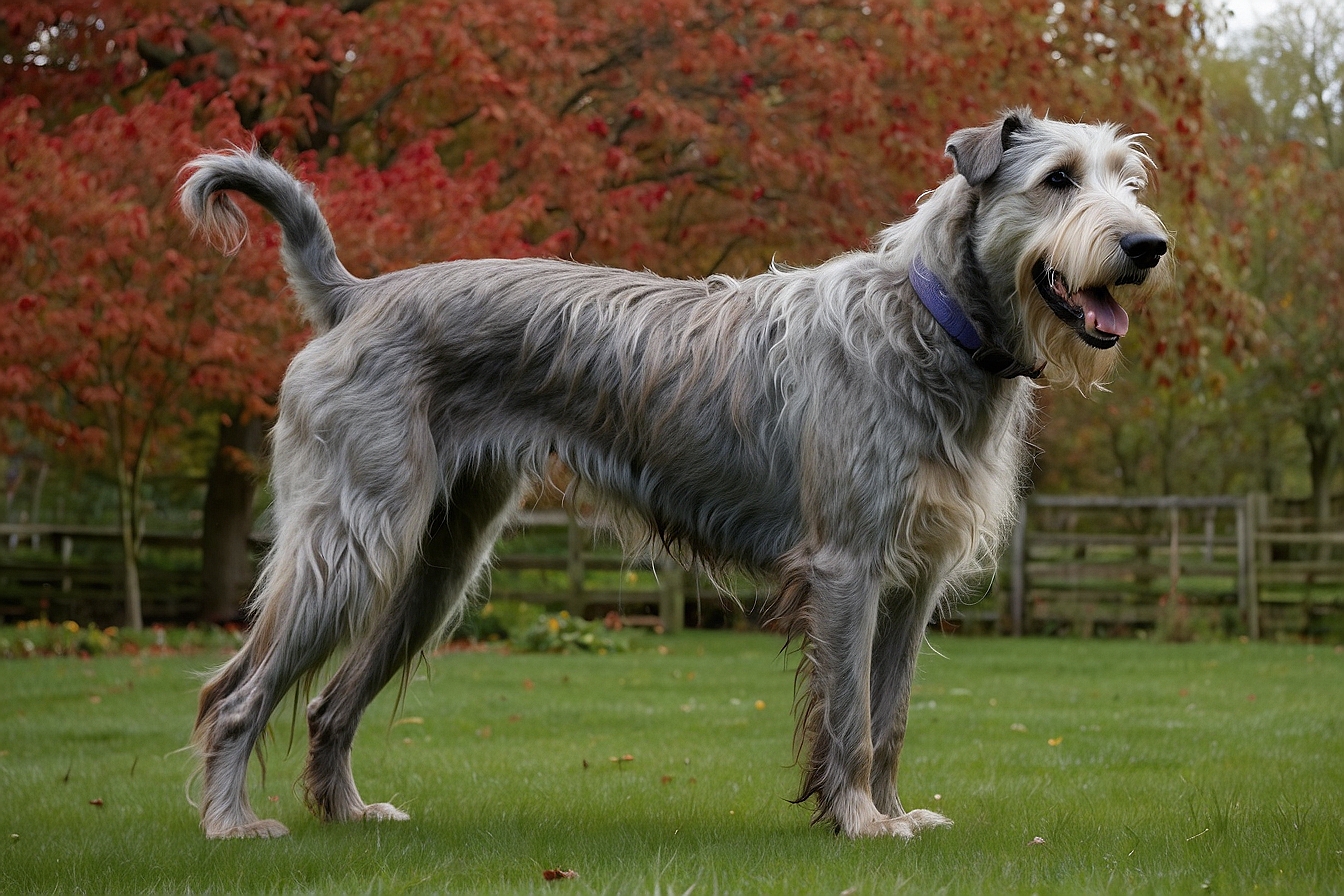
Updated On: April 21, 2024 by Fatma Mohamed
The Irish wolfhound, with its commanding presence and storied past, has long been enshrined in the tapestry of Irish culture and, by extension, has come to symbolise much of what is respected and cherished about the heritage of Ireland. These hounds, known for their impressive size and strength, are woven into the history and mythology of Ireland, standing as a testament to the nation’s values of nobility and courage.
Table of Contents
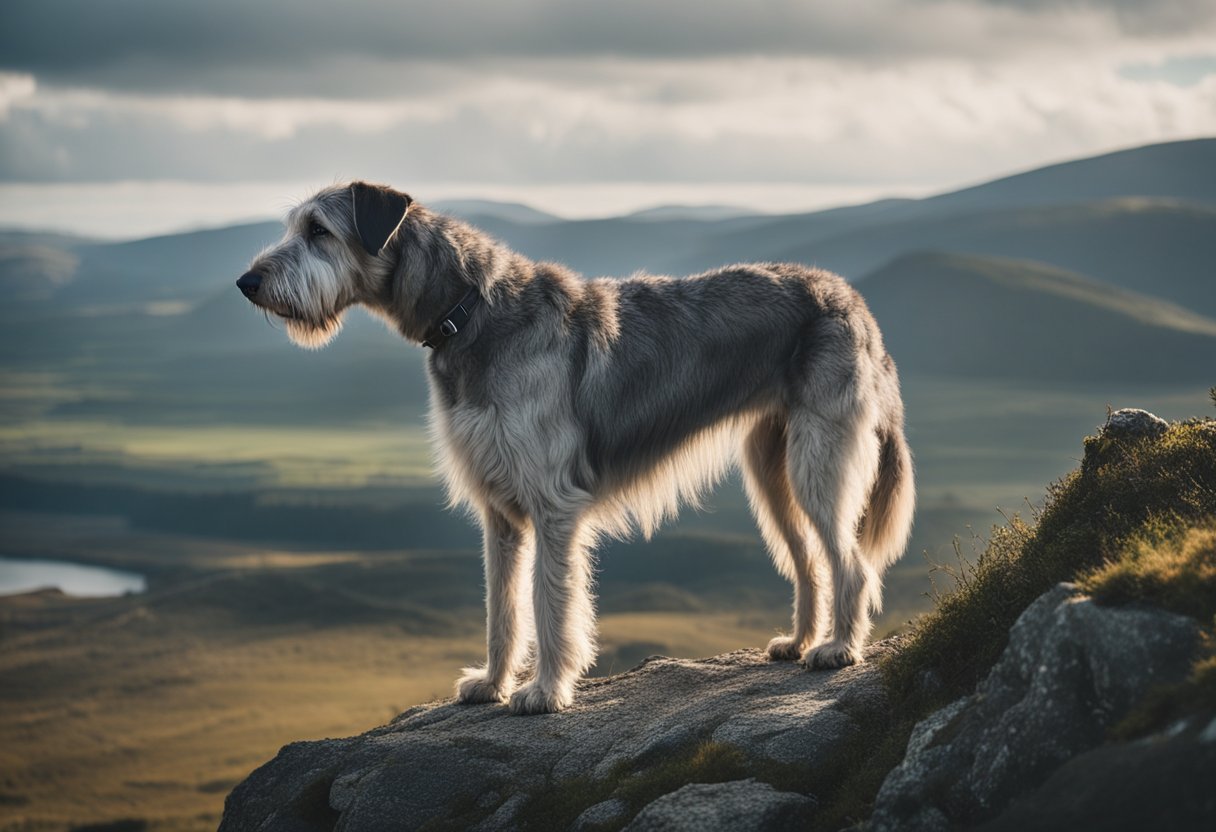
Tracing their roots back to antiquity, these gentle giants were once the companions of Celtic chieftains and the favoured breed of Irish nobility, a status reflected in ancient laws that stipulated only royalty could keep them. Today, the Irish wolfhound endures as a symbol of integrity and honour, embodying the rich storytelling traditions of the Emerald Isle through its depiction in art, literature, and folklore. They remain a proud emblem of Irish identity and resonate with the tenacity, kindness, and spirit of a nation that holds fast to its traditions while facing a modern world.
Origins and History of the Irish Wolfhound
We delve deep into the storied past of Ireland’s most iconic breed, discovering its ancient roots and the cultural reverence it commands.
Ancient Roots and Celtic Symbolism
The Irish Wolfhound boasts a history interwoven with the fabric of Ireland itself, embodying the spirit and strength of ancient Celtic culture. Evidence suggests that these majestic hounds were present in Ireland by 273 BC, showcasing their enduring presence throughout the ages. Their size and prowess elevated them beyond mere pets; they were an integral aspect of Celtic mythology and a symbol of the ancient high kings of Ireland.
Within the tapestry of history, Rome itself stands witness to the grandeur of these hounds. Julius Caesar mentioned them in his accounts of the Gallic Wars, and Symmachus, a Roman consul, noted their receipt as a gift, which testifies to their esteem and exoticness even then.
Reverence in Gaelic Culture and Mythology
The Irish Wolfhound’s significance extends into the realm of the mythical, gloriously intertwining with the legends of figures such as Cú Chulainn, Ireland’s illustrious warrior from Irish mythology. These dogs were not just companions to Celtic warriors but also coveted emblems of might and nobility. Our Wolfhound’s historical pedigree is undeniably a proud cornerstone of the Irish identity.
In Gaelic sagas and folklore, the Wolfhound’s depiction goes beyond the earthly, oftentimes festooned with magical qualities and an elevated status that reflects the ancient society’s deep reverence for this breed. The hound’s association with Gaelic nobility and their featuring in many a myth only accentuates their integral role in the cultural and historical narrative of Ireland.
Physical Characteristics
Before delving into the specifics, understanding the physical attributes of the Irish Wolfhound is pivotal. This dog breed is renowned for its imposing size and muscular build, a true reflection of its sighthound lineage.
Breed Standards and Size
According to the breed standards, an Irish Wolfhound should exhibit both strength and grace. The ideal height for males is at least 81 centimetres (cm) at the withers, with females standing at a minimum of 76 cm. They can weigh upwards of 54 kilograms (kg), making them one of the largest dog breeds.
- Height: Minimum 81 cm (Males), 76 cm (Females)
- Weight: Generally over 54 kg
- Appearance: Muscular and graceful
Comparison With Other Sighthounds
Compared to other sighthounds, such as the Scottish Deerhound, the Irish Wolfhound is taller and more substantially built, possessing a more muscular frame. Where the Scottish Deerhound is built for speed, the Wolfhound combines speed with power, facilitating its historical role in hunting and battle.
- Irish Wolfhound: Taller, heavier, and more muscular
- Scottish Deerhound: Slimmer, built for speed
Both breeds, however, share common sighthound attributes of keen sight and a slender, streamlined body conducive to high-speed pursuits.
Symbolism and Representation
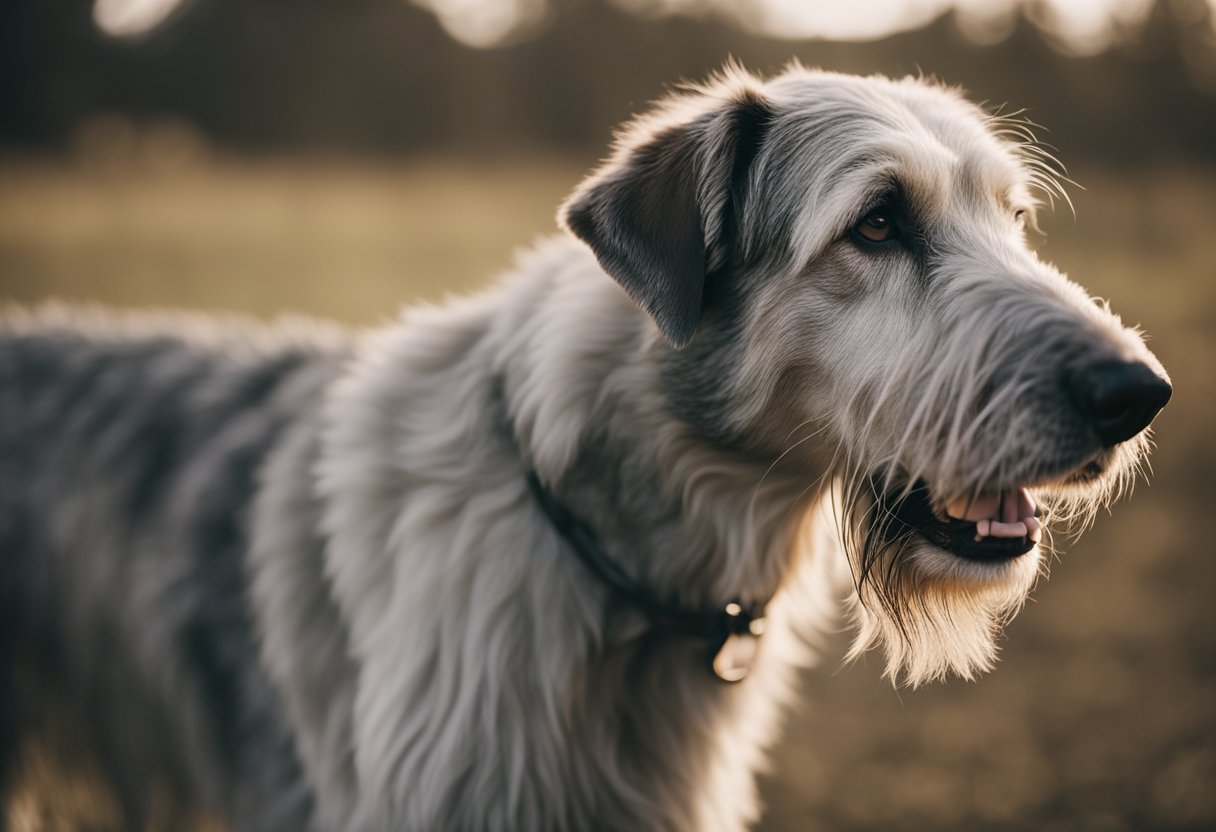
Within the tapestry of Celtic culture, the Irish wolfhound has held a revered place, standing not just as a mere dog but also as a potent symbol interwoven with Ireland’s history and mythical lore. Its representation spans from emblems signifying nobility and bravery to depictions in art capturing the essence of the otherworld.
The Wolfhound in Irish Emblems and Artefacts
Representing more than a symbol of royalty, the Irish wolfhound is deeply entrenched in Irish emblems and artefacts. It epitomises bravery—a quality admired in Celtic warriors of yore. Indeed, the wolfhound has graced various historical artefacts, embodying the indomitable spirit of ancient Ireland. For instance, the iconic statue of Daniel O’Connell in central Dublin proudly features noble wolfhound statues, which underscore O’Connell’s monumental stature in Irish history.
This breed’s presence extends well beyond sculptures; it is also depicted in other cultural artefacts found throughout Ireland, including the Dublin GPO, where the emblematic value of the dog mingles with the spirit of national pride and endurance. Such images echo the wolfhound’s perceived role as a guardian of the otherworld, a concept deeply rooted in Celtic spirituality.
Modern Cultural Significance
Today, the Irish Wolfhound’s symbolism permeates modern Irish culture, where its likeness is a testament to historical values cherished by the people. It conveys a spiritual meaning, binding the past with the present through its continued presence in artistic works and public memorials across Ireland.
Fittingly, the Irish Wolfhound has become an emblem of Irish identity, celebrated in various contemporary settings. Whether featured on official insignias or adopted as mascots for modern institutions, this iconic dog maintains its status as a living symbol of Ireland’s rich heritage and enduring legacy. Its connection to the storied past—infused with the mythic and the spiritual—continues to inspire and resonate with those who honour the profound heritage of the Emerald Isle.
Temperament and Behaviour
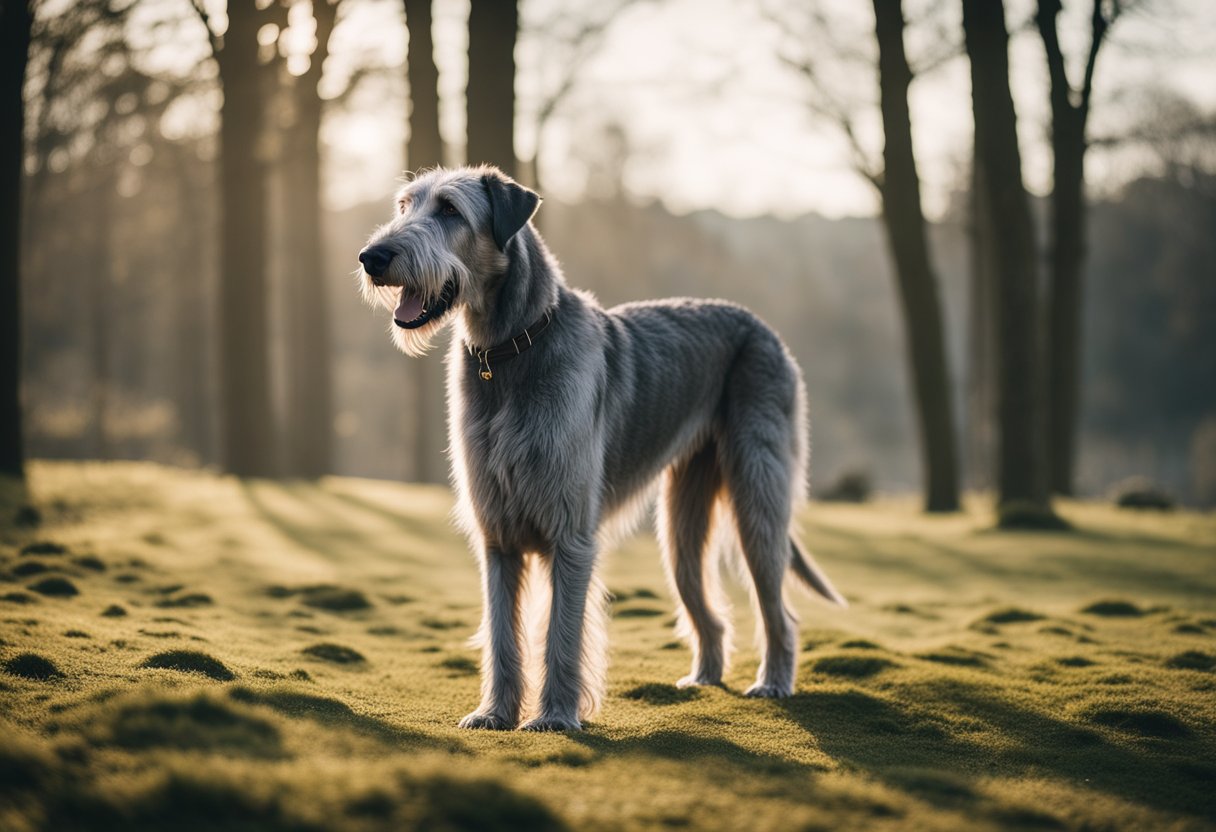
The Irish Wolfhound is synonymous with a noble temperament, often described as a breed epitomising gentleness and loyalty.
The Gentle Giant Persona
We find the Irish Wolfhound to be the embodiment of the ‘gentle giant’ archetype, displaying a congenial temperament that belies its imposing stature. Renowned for their gentle nature, these hounds are loyal companions, projecting a sense of calm trustworthiness that aligns with their historical standing as guardians of the home and hunters of old.
Allowing their independent spirit to flourish does not contradict their desire for companionship; rather, it complements their ability to think for themselves. Irish Wolfhounds thrive in environments that respect their composed demeanour and reward their patient outlook on life.
Their trustworthiness is a hallmark that attracts many to the breed, resonating deeply with those who seek a loyal friend and a devoted family member.
In Literature and Folklore
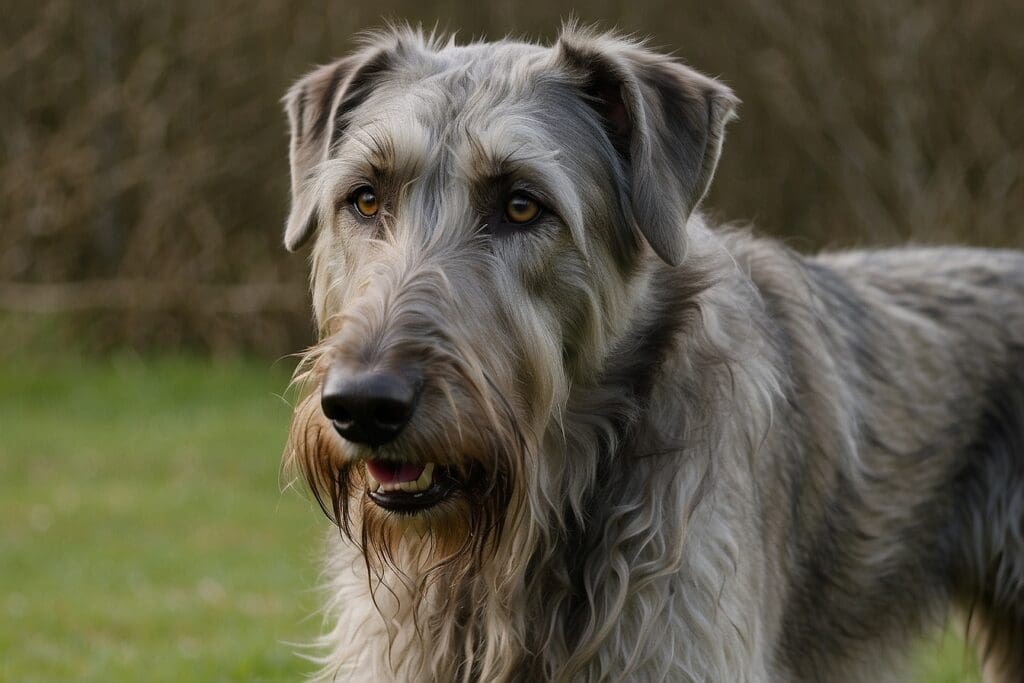
The Irish Wolfhound is deeply entrenched in the rich tapestry of Irish literature and folklore, often symbolising nobility and bravery.
Tales of Cú Chulainn and Other Legends
In myth, these hounds are as legendary as the heroes they accompany. The most renowned is Cú Chulainn, whose very name translates to ‘the hound of Culann’, asserting his intrinsic link to these mighty dogs. Cú Faoil is the Gaelic word for hound, and these animals are celebrated companions in tales where they reflect the hero’s qualities, serving as symbols of strength and loyalty. The legend of Cú Chulainn and his loyal hound, Brán, stands as a testament to the cultural significance of the wolfhound in early Irish storytelling.
Wolfhounds in Irish and Roman Accounts
Wolfhounds have not only captivated the Irish imagination but also impressed foreign accounts. Roman consul Tacitus remarked on the awe-inspiring size and power of these dogs. Irish historical accounts and annals often mentioned wolfhounds, detailing their importance in both hunting and warfare. This dog’s prowess and stature transcended borders, embedding it firmly into Irish and Roman historical narratives, further cementing its cultural significance throughout the centuries.
Roles and Utility
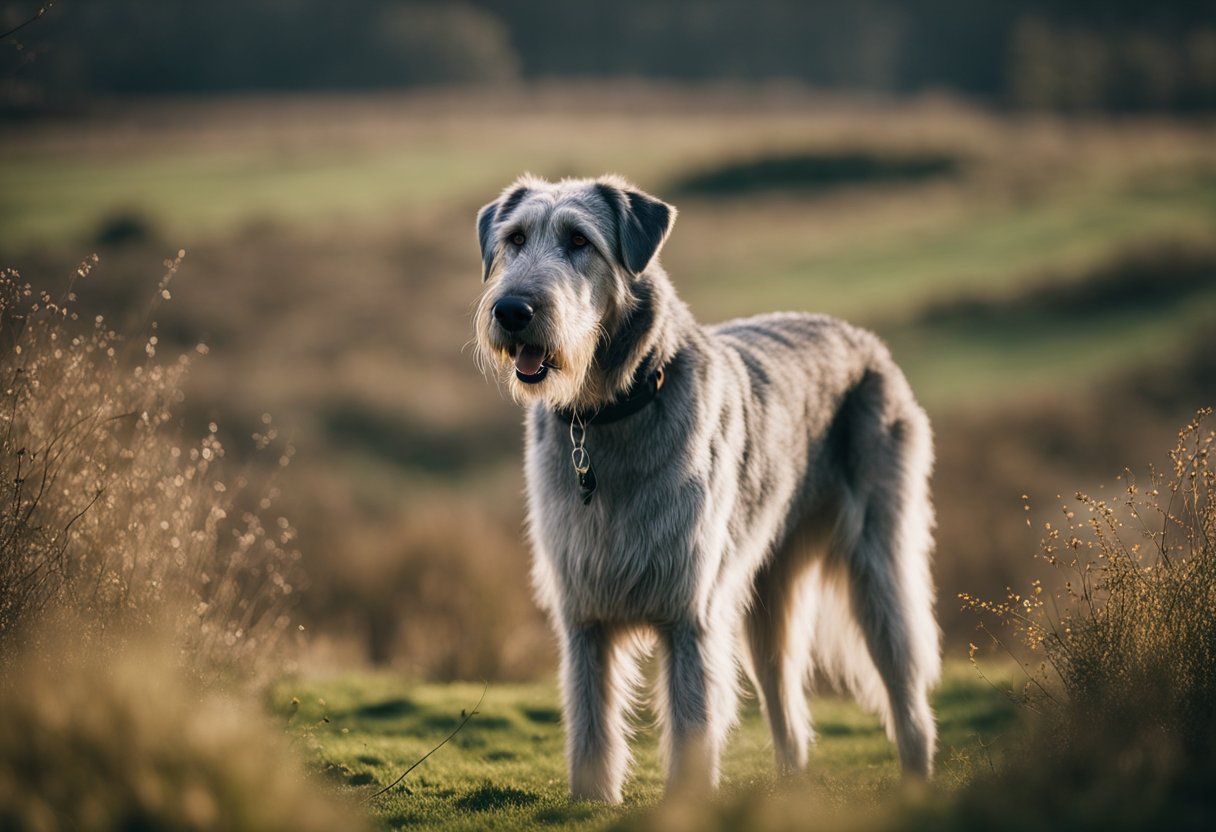
The Irish Wolfhound, steeped in a grand tradition, has served roles that extend beyond companionship, acting as a pivotal figure in hunting, warfare, and as a symbol of status and power throughout Irish history.
Hunting Companions and War Hounds
Originally bred for the rigour of hunting and war, the Irish Wolfhound was a formidable force in chasing down large game such as elk and boar, making them invaluable hunting companions. Their size and strength also lent themselves to the chaos of battle, where they were utilised as impressive war hounds. They carried the same tenacity as the warriors they accompanied, showcasing their bravery and loyalty on the battlefield.
Protectors and Status Symbols
The presence of an Irish Wolfhound was often indicative of nobility and status among chieftains and kings. Under Brehon law, the ownership of these hounds was restricted to those of high rank, and they were bestowed as royal gifts to signify respect and allegiance. Their role as protectors was a natural extension of their loyalty and physical prowess, guarding homes against intruders and ensuring the safety of their noble families.
The Irish Wolfhound in Modern Use
Today, the Irish Wolfhound is less commonly found on the battlegrounds. Instead, they have transitioned to more peaceful roles, reflecting the dog’s gentle nature. They serve as beloved protectors and family pets, though their regal bearing still speaks to their storied past. Irish military regiments celebrate their heritage by featuring the Irish Wolfhound as a mascot, symbolising the unwavering power and loyalty intrinsic to the nation’s identity.
The Irish Wolfhound as a National Symbol
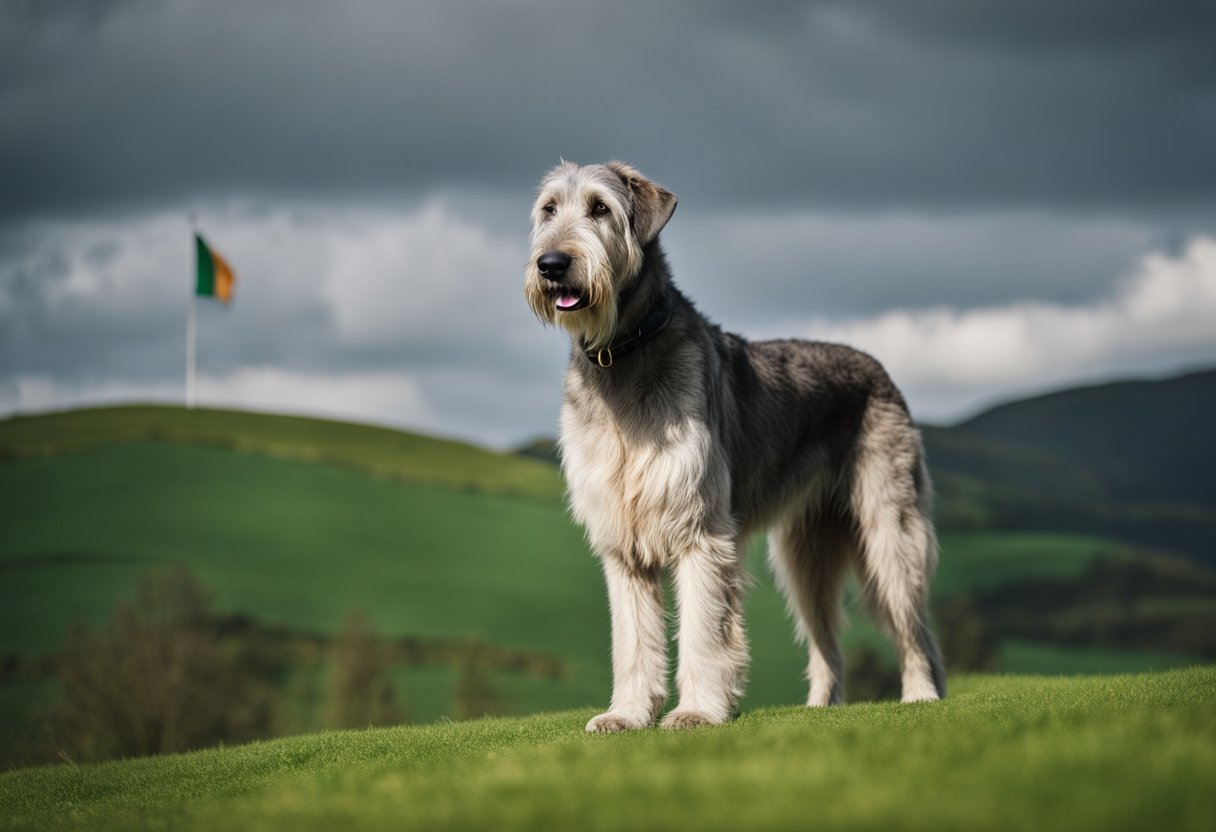
The Irish Wolfhound not only captures the spirit of Ireland but also symbolises its rich cultural legacy, holding a special place on occasions of national pride and in the emblems that narrate Ireland’s history.
Prominence in National Celebrations
Irish Wolfhounds are celebrated as part of National Dog Day, where we spotlight their significance as Ireland’s national dogs. Their appearances in parades and events across the Emerald Isle showcase the breed’s stature and dignity, characteristics that mirror the spirit of Ireland itself. These gentle giants, with their towering presence and noble demeanour, act as living symbols of Irish culture during these festivities.
Representation of Historical and Cultural Objects
The Irish Wolfhound’s representation is etched in Ireland’s history and everyday culture, from the sixpence coin to fine items like Belleek pottery. They are seen in intricate designs that adorn traditional Irish crafts, encapsulating the essence of Celtic culture. Moreover, brands like Tullamore Dew whiskey also draw from this heritage, often incorporating the Wolfhound as a mark of authenticity and nobility, aligning their legacy with Ireland’s. These historical and cultural objects act as enduring gifts, enhancing the breed’s role as a spirit animal and emblem of Irish identity.
Breeding and Conservation
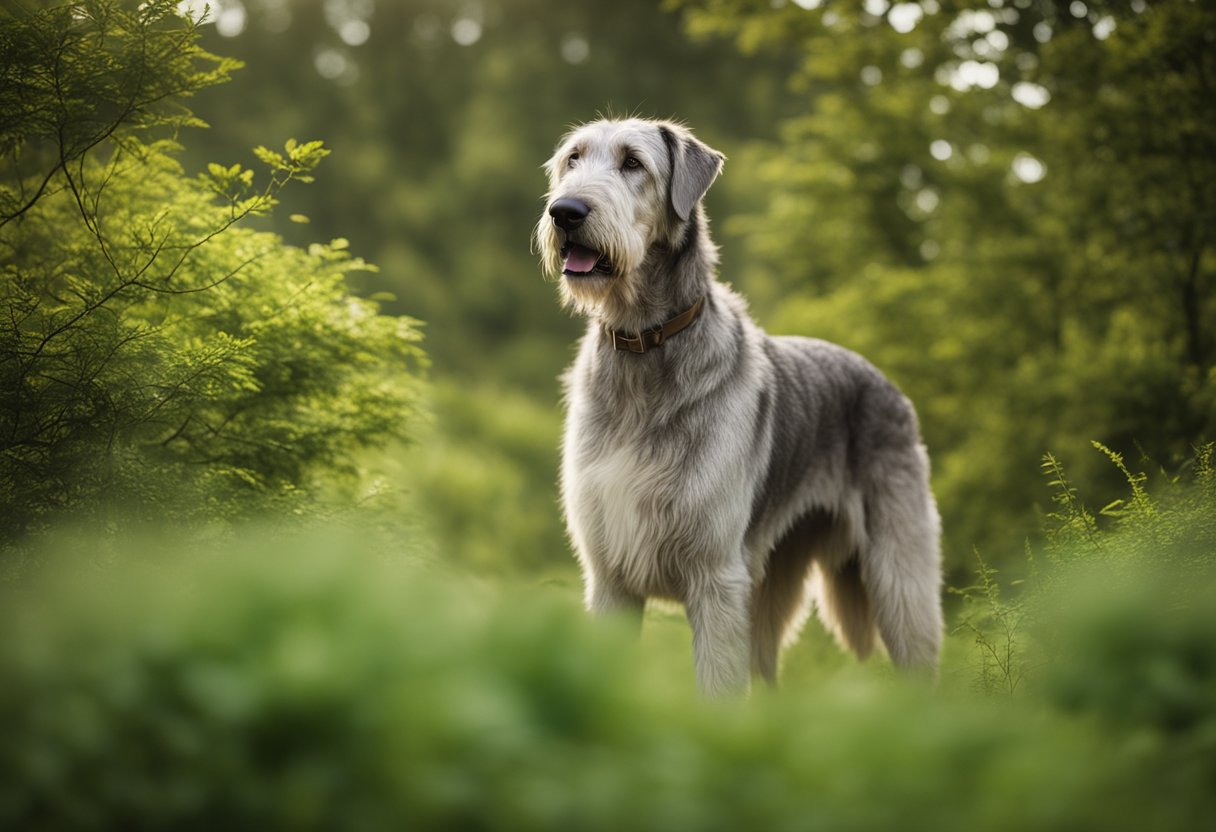
As custodians of one of the oldest dog breeds, we acknowledge our duty to preserve and maintain the Irish Wolfhound’s majestic lineage. Our work in conservation ensures these regal canines continue to meet the breed standard, which defines their distinct physical and temperamental qualities.
Efforts to Preserve the Breed’s Lineage
We commit ourselves to the ethical breeding practices that are central to the preservation of the Irish Wolfhound. By upholding a comprehensive breed standard, we aim to maintain the health, structure, and characteristics that the breed is known for. It is not simply about appearance; it is about ensuring the vitality and longevity of these magnificent animals.
- Pedigree Tracking: Meticulously documenting pedigrees helps us track health trends and genetic diversity, which is crucial for reducing heritable conditions.
- Health Screenings: Regular health screenings for breeding stock identify potential health issues early, helping to prevent the passing of these issues to progeny.
- Selective Breeding: Choosing suitable mates involves evaluating temperament, health, genetic diversity, and adherence to breed standards.
- Education for Breeders: Providing breeders with resources and knowledge strengthens the community’s capacity for conservation.
- Collaboration with Registries and Clubs: We work closely with canine registries and breed clubs to align our efforts with international standards.
- Public Awareness: Educating the public on the breed’s history and needs fosters a community of informed caretakers and enthusiasts.
Through these concerted efforts, we safeguard the lineage of the Irish Wolfhound, ensuring that future generations can witness the noble characteristics of this ancient breed.
Notable Wolfhounds in History

The revered Irish Wolfhound holds a storied position throughout Ireland’s history, often interwoven with the tales of nobles and royalty. These majestic hounds served not just as hunters but as symbols of status and nobility.
Famous Historical Wolfhounds and Owners
Gelert, a wolfhound of legend, was bestowed upon Prince Llewelyn of Wales by King John of England. The hound’s tale is one of loyalty and tragedy, encapsulating the essence of the breed’s character. Gelert’s story reflects the pivotal role of wolfhounds in royal narratives and their profound impact on culture and myth.
Irish mythology recounts the exploits of Bran and Sceolán, hounds of the warrior Fionn mac Cumhaill. These hounds, believed to have been transformed humans, are prominent figures showcasing the bond between chieftains and their wolfhounds.
In ancient times, ownership of these hounds was a privilege reserved for the elite. Brehon law, a set of ancient Irish legal statutes, specified that only kings and nobles, such as chieftains could possess an Irish Wolfhound, underscoring their status as living historical artefacts.
Conbec, an ancestor of the modern Irish Wolfhound, was another exemplar of dogdom admired for his hunting prowess and esteemed by nobility throughout Irish history.
Our exploration reveals the Irish Wolfhound as a symbol of power and nobility, intertwined with Ireland’s history through extraordinary stories, from the royal courts of ancient chieftains to the haunting legends that echo through time.
Irish Wolfhound in Modern Media
In recent years, the Irish Wolfhound has become a notable figure in modern media, symbolising a blend of nobility and gentleness. Our fascination with this breed extends beyond their imposing stature to their representation in various forms of entertainment and communication.
In film and television, Irish Wolfhounds have made memorable appearances, highlighting their serene nature and physical grandeur. Their roles often reinforce the breed’s historical association with Irish nobility, as they are frequently cast alongside kings and warriors.
Advertising has also seen the Irish Wolfhound’s image used to evoke trust and reliability. Emphasising their authenticity, companies with roots or connections to Ireland have adopted the breed as a mascot. This usage taps into the rich cultural symbolism the dog carries.
On social media platforms, Irish Wolfhounds are stars in their own right. Numerous accounts dedicated to these gentle giants allow us to share and receive daily updates on their lives, helping to continuously grow their popularity and embed them into pop culture.
Within literature and online articles, the breed is often featured in stories that accentuate their majestic presence and historic importance, weaving them into the narrative of Irish history and its modern-day cultural expressions.
| Context | Representation |
|---|---|
| Film & Television | Noble companions to historical figures |
| Advertising | Symbols of trustworthiness and connection to Ireland |
| Social Media | Focus of dedicated accounts and cultural discussions |
| Literature | Emphasised for their historic and cultural importance |
We take pride in observing how the Irish Wolfhound continues to gracefully stride through modern media, embodying Ireland’s illustrious heritage and the universal admiration for dogs.
Frequently Asked Questions
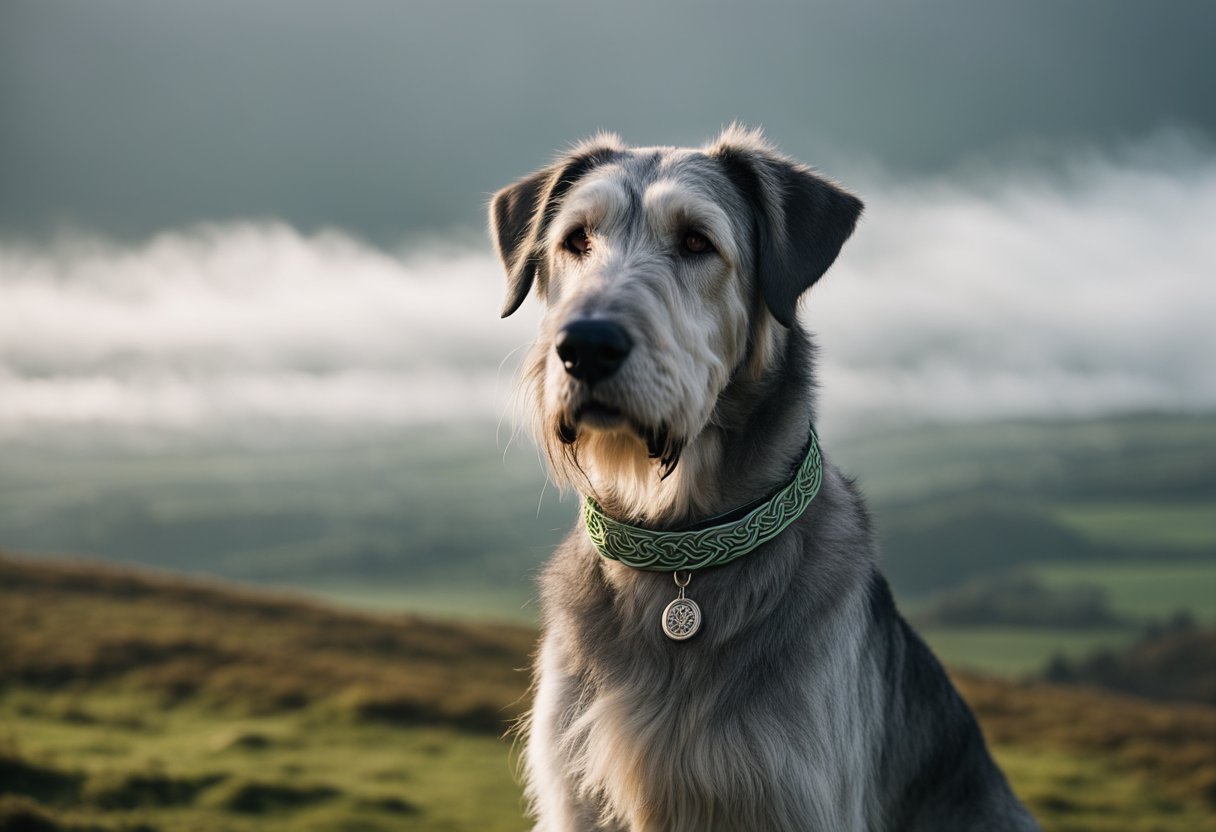
In our journey to unfold the layers of the Irish Wolfhound’s symbolism, we explore key aspects that weave into the cultural fabric of Ireland. These noble canines are much more than pets; they’re capsules of history and legend.
What does the Irish Wolfhound represent in cultural lore?
The Irish Wolfhound is deeply ingrained in Irish lore as a symbol of nobility and loyalty. These noble creatures were once the companions of kings and warriors, esteemed for their grandeur and stoic presence.
What purpose did Irish Wolfhounds historically serve?
Historically, Irish Wolfhounds served as hunting dogs, particularly valued for their ability to pursue and take down large game. Their remarkable size and strength made them unparalleled in the hunt for wolves and elk.
What are the legendary stories associated with Irish Wolfhounds?
Tales of Irish Wolfhounds are woven through Irish mythology, venerating them for their bravery and loyalty. Bran and Sceolán, the hounds of Fionn mac Cumhaill, are prime examples, revered in the Fenian Cycle for their extraordinary characteristics.
In Irish mythology, what role do Wolfhounds play?
In Irish mythology, Wolfhounds often play roles that highlight their attributes of protection and companionship. They are depicted as guardians of their masters and the spirit of Ireland itself, showcasing their importance in mythic tales.
How have Irish Wolfhounds been symbolically portrayed in literature?
In literature, the Irish Wolfhound is frequently portrayed as a symbol of nobility and integrity. Their depiction emphasises their historic association with Irish nobility and their stalwart character.
What significance do Irish Wolfhounds hold in heraldry and coat of arms?
Irish Wolfhounds hold significant importance in heraldry and coats of arms, symbolising power and vigilance. Their images grace various emblems, highlighting their role as protectors and their esteemed stature in Irish history.






